A Historical Temple On The Borders Of India-Pakistan.

Koteshwar is 166 kms from Bhuj, the District Hqrs of Kutch District of Gujarat. Koteshwar is located on the last piece of land on the Kori Creek(Kutch Creek) which separates India from Pakistan in the Arabian Sea.It has an excellent road with couple of small towns coming on the way, like Mata no Madh.
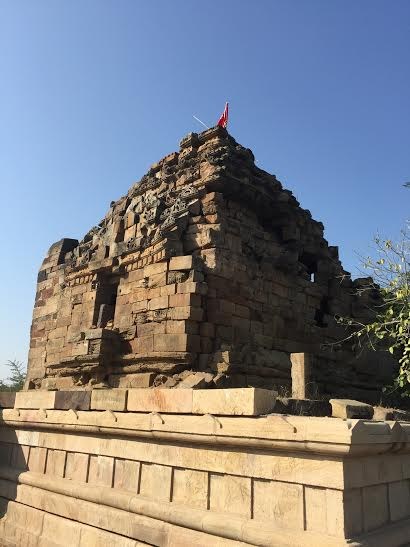
This is Purneshwar Temple which is around 30 Kms from Bhuj. It is an old Shiv Temple built around 9th century but not much is known about it. It was twice destroyed by the Earth Quakes of 1819 and 2011. It is a neglected site and that appears to be astonishing that an art as ancient as 9th century is gathering dust. Long time back in 1980s when I called on the Chief Priest here, he requested for electricity in the Temple. Though electricity was provided by the Govt., the site also needs to be upgraded and restored.
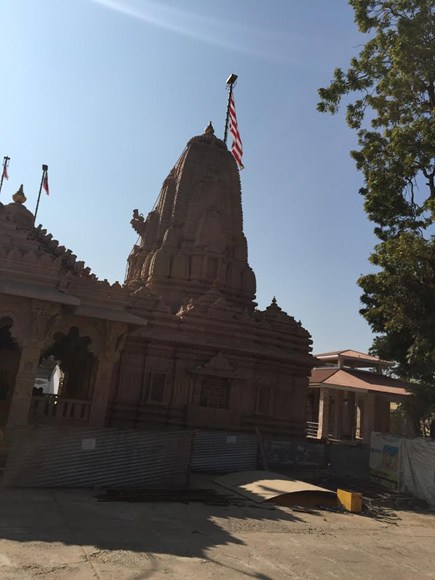
Mata no Madh is name of the place, where the famous temple of Ashapura Maa, the head deity of Kutch Rajputs and family diety of Jadeja rulers stands. It is located about 80 km from Bhuj.
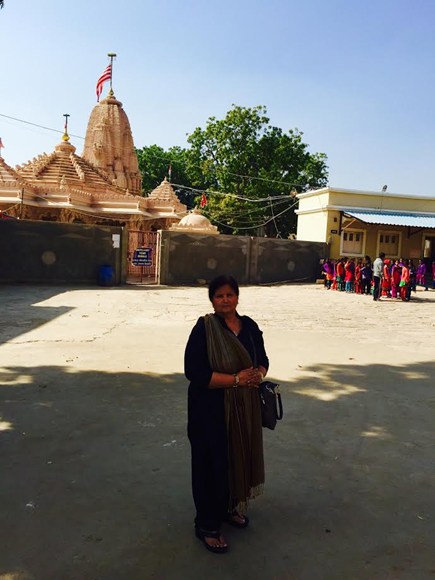
The temple was built in the 14th century by Ajo and Anagor,two Karad Banias. They were the ministers in the court of the father of Lakho Fulani. The Earth Quake of 1891 damaged the temple. Within 5 years Sundarji Shivji and Vallabhaji, two BrahamKshatriyas repaired it. It was rebuilt by the local artisans, mainly Mistries(masons)of Kutch who were well known then and even now,but most of them have migrated to other countries in search of jobs.This ancient temple is now 58 ft. long, 32 ft. wide and 52 ft. tall. Once again the earthquake of 2001 AD shook it and its dome tumbled down. However, very soon it was repaired and now it stands with a new grandeur.
There are two temples, the original old temple above the hill, which lies abandoned as after the earthquake of 1819, a new temple below the hill was built, which now houses the deity and is in use ever since. The picture above shows my wife standing in front of the temple gate. The Temple is looked after by the Head Priest from the Kapdi community and is known as Raja Bava.There are many other priests also who are working on the various positions in the temple. The Temple serves free food every day. There is huge Mela (Fair) held around Vijayadashmi and during this Navratri period many people go on foot from Bhuj to visit this temple on the auspices dates. People from the erstwhile Royal family also visit this temple to perform the Maha Puja around last day of the Navratri.
This the beginning of the 2km drive to Narayan Sarovar and Koteshwar.
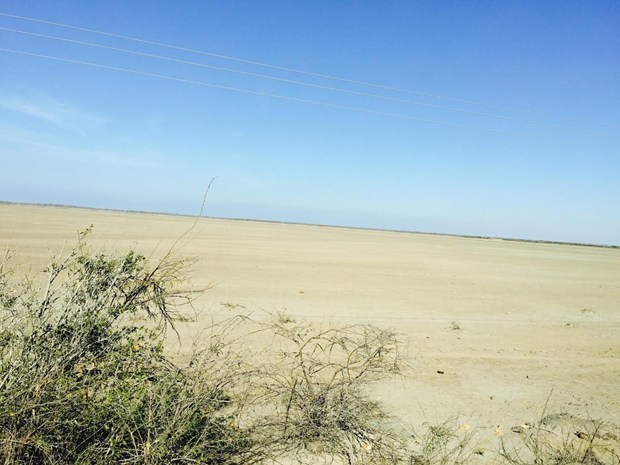
Till we reach the above Arches, the land is barren, sandy but has lot of potential for gypsum,china clay,lignite and other minerals.The land is rocky, uncultivated with sparse bushes of babool and other desert acacia plants. A few Kilometers from here is the plant of the Sanghi Cements which is almost on the borders of Indo-Pakistan in Kutch. Kutch has reserves of lignite, bentonite and other sodium based minerals.
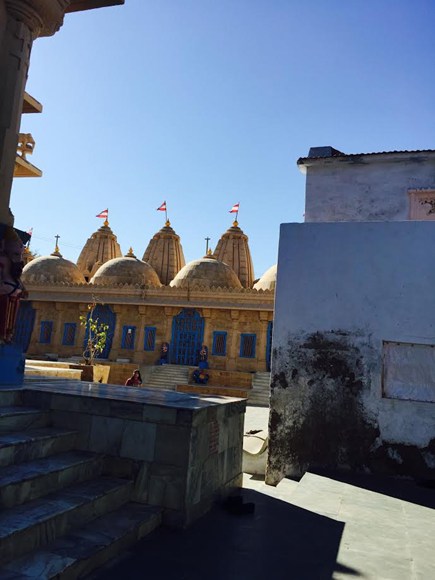
Narayan Sarovar is one of the most sacred pilgrimage sites for Hindus. It is one of the five holy ponds in India mentioned in ShrimadBhagwat Geeta.Narayan Sarovar means the Lake of Narayan, a name for Vishnu.As per legends, one of the holy rivers of India, Saraswati River had an out let in to sea near the present day Narayan Sarovar and waters of lake were filled with holy waters of River Saraswati, that is why this place was and is still considered as one of the five holy lakes by Hindus.Legends say that there was also a lake built by Alexander the Great which disappeared during the earthquake in 1819.
In this place there are Vaishnav temples of Shri Trikamraiji, Laxminarayanji, Govardhannathji, Dwarkanath, Adinarayan, Ranchodraiji and Goddess Lakshmi.The Queen of King Rao Deshalji II(Jadeja Dynasty) of Kutch had built these temples. Devotee from all over India come to worship the lords here. The architecture is ancient and awe-inspiring.The temples of Lakshminarayan and Trikamray are built in same style as Dwarka temple. The other five temples were built around the same period 1780-1790.
According to Hindu theology, there are five sacred lakes collectively called Panch-Sarovar (Five Lakes),namely Mansarovar(Himalayas, UP Hills), Bindu Sarovar(Orissa) Narayan Sarovar Pampa Sarovar(Karnataka) and Pushkar(Rajasthan). A fair is held here on the 11th to 15th day of month of Kartik of the Hindu calendar (November/December).
Mahaprabhu Vallabhacharya during his lifetime is said to have visited Narayan Sarovar and spent some time here and as such the site is sacred also for followers of Pustimarg (Vaishnavas)
Here, you can also see red antelopes or chinkaras and in year 1981 the area around was notified and named after Narayan Sarovar as Naryanasarovar Sanctuary.
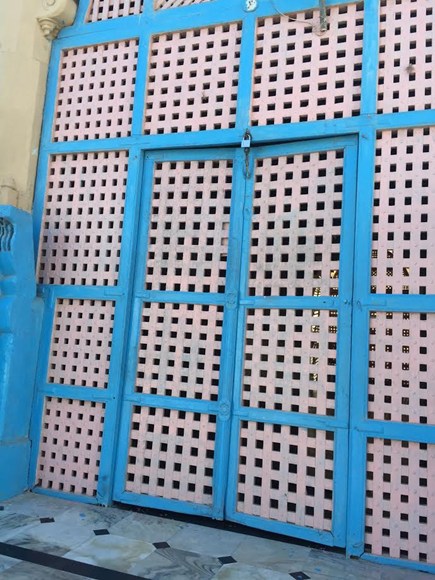
This picture is of the Office and storage room as well working rooms of the Narayan Sarovar Trust .These are old buildings but have been restored to some of the old constructions. When we visited the Sarovar in Dec.2014, the lake was partially dry and the residual water was turgid. The Temple trust and the Govt. of Gujarat need to attend to the dryness of the lake by finding out some way to keep the lake perennial filled with clean water. People come from distant areas and beyond to pay a visit to this holy place and when they find the lake to be dry, they are unhappy and upset. The practice of the Hindu trust to keep the portals of the Temple closed during the afternoons here and in almost all other temple cities can be set right by keeping an additional staff to attend to the temple during the afternoons. Most of the people have no time to wait and this perhaps causes a loss to the spread of the religion.When questioned in this regard, the caretakers say that the Gods are taking rest. Silly notion. Can the Almighty ever sleep. If he sleeps what will happen of the world.
There is also a temple of Adinarayan in the village of Narayan Sarovar near the lake.
Seven stone temples are in a covered courtyard approached from the lake by flights of stone-steps and bordered by a strong wall. The wife of Rao Desalji (1718-1741), Vagheli Mahakunvar built the temples of Lakshminarayan, Trikamray, Adinarayan, Govardhannath, Dwarkanath and Lakshmiji in 1734. The temple of Trikamray is in the same style and shape like that of Koteshwar. It is 72 feet long, 68 1\2 feet wide and 61 feet high and it has three side covered buildings with a large one in the centre, all capped with domes resting on twelve feet high pillars.
The stone and wood frames at the entrance are luxuriously stamped. The doors are plated with silver in which flowers, fruits, leaves and creepers are with inscripted. The shelter of the God stands on a base and is supported on four silver pillars with fine spiral flutes. There are three Guphas(Caves) besides these temples: Ram Gupha, Lakshaman Gupha and Shesh Gupha
This picture is of the Office and storage room as well working rooms of the Narayan Sarovar Trust .These are old buildings but have been restored to some of the old constructions. When we visited the Sarovar in Dec.2014, the lake was partially dry and the residual water was turgid. The Temple trust and the Govt. of Gujarat need to attend to the dryness of the lake by finding out some way to keep the lake perennial filled with clean water. People come from distant areas and beyond to pay a visit to this holy place and when they find the lake to be dry, they are unhappy and upset. The practice of the Hindu trust to keep the portals of the Temple closed during the afternoons here and in almost all other temple cities can be set right by keeping an additional staff to attend to the temple during the afternoons. Most of the people have no time to wait and this perhaps causes a loss to the spread of the religion.When questioned in this regard, the caretakers say that the Gods are taking rest. Silly notion. Can the Almighty ever sleep. If he sleeps what will happen of the world.
There is also a temple of Adinarayan in the village of Narayan Sarovar near the lake.
Seven stone temples are in a covered courtyard approached from the lake by flights of stone-steps and bordered by a strong wall. The wife of Rao Desalji (1718-1741), Vagheli Mahakunvar built the temples of Lakshminarayan, Trikamray, Adinarayan, Govardhannath, Dwarkanath and Lakshmiji in 1734. The temple of Trikamray is in the same style and shape like that of Koteshwar. It is 72 feet long, 68 1\2 feet wide and 61 feet high and it has three side covered buildings with a large one in the centre, all capped with domes resting on twelve feet high pillars.
The stone and wood frames at the entrance are luxuriously stamped. The doors are plated with silver in which flowers, fruits, leaves and creepers are with inscripted. The shelter of the God stands on a base and is supported on four silver pillars with fine spiral flutes. There are three Guphas(Caves) besides these temples: Ram Gupha, Lakshaman Gupha and Shesh Gupha
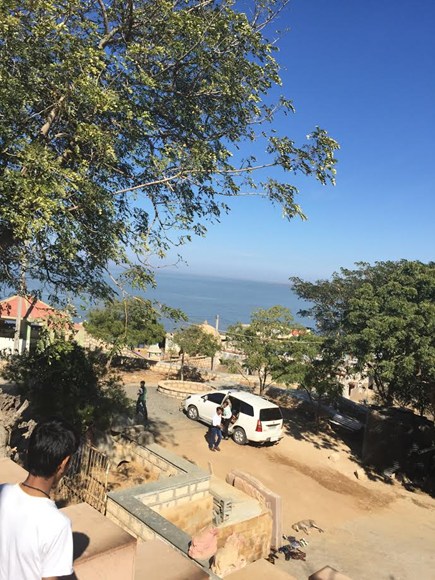

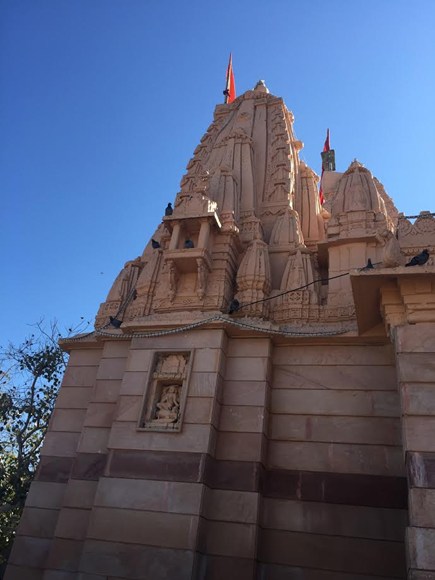
Koteshwar is situated in the Kori Creek of the Arabian Sea on the western end of Kutch just opposite to Karachi-Pakistan, and 2 kms from Narayan Sarovar.As stated in a legend, when Lord Shiva was delighted with the worship and sacrifice of Lanka King Ravan, he gave him a Ling-full of religious power. Lest Ravan's ambition become endless as a result of this advantage, all the Gods united together and conspired to gain the Ling from Ravan through dishonesty and got it installed here and thereafter known as Kotilengeshwar. According to Hieu-en-Tsiang, a Chinese traveler of 7th century Koteshwar port extended five miles in boundary near the mouth of the river Indus, which used to follow along the coast of Kutch till the great earth quake referred above.He adds that there were 80 monasteries with about 5000 monks in them during the good days. 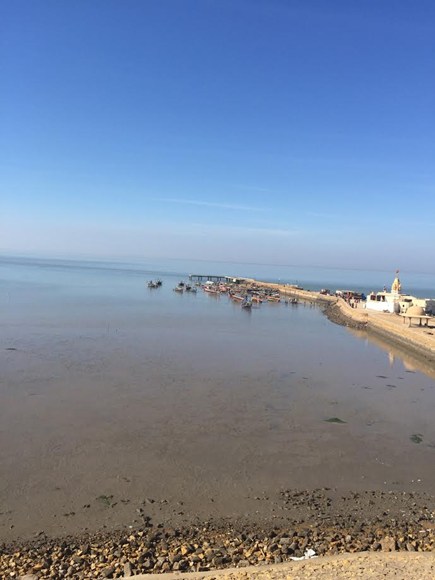

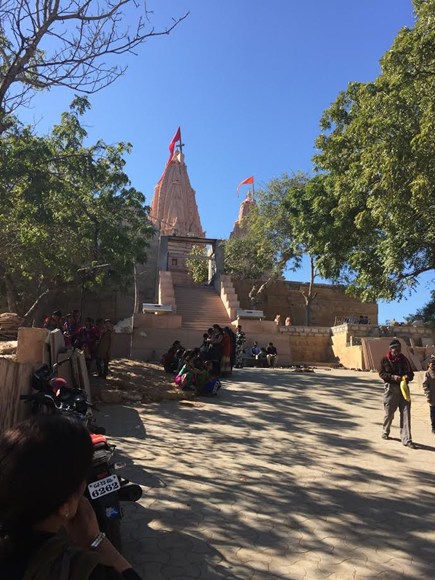
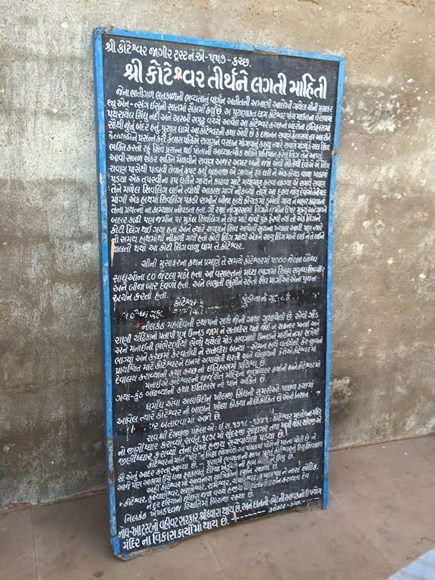
The above board (in Gujarati language) says that the temple is part of the Government Trust and the donations-income obtained from it is used for the development of the Temple.It also says the Huen Tsang a chinese traveler of 7th century said that the ancient temple was in the midst of the sea and there were 12 other smaller temples, which were the abode of Shaivites Sadhus who performed their puja's here. The writing also speak about the killing of Unnad son of Gond Queen Chandrika who was associated with the installation of the Neelkanth Mahadev temple. He was killed by the local kings and administrators through conspiracy and cheating. The writing also says that the Mahant of the Temple enjoyed the status of "Pirs" and Pirs in this area were well respected.. The attempts of Allahaudin Khilji to destroy this temple is also visible here and there is a spot where he tried to strike at the door of the Koteshwar Temple.
The writings on the left side of the gate also shows that the present fort and temple were re- constructed in 1820 by Sheth Sundarji and Jetha Shivji a Brahmakshatriya. The Temple's terrace has three domes. Under the central dome, there is a large and beautiful carving presented by Rao Desalji, the Jadeja Dynasty ruler. In the right dome, there is a large stone image of Hanuman and in the left dome; there is a large stone image of Ganpati. Inside the porch, there is a hall Mandap with a large central and two side domes. At the internal end of the hall, there are holy niches along with figures of Ganpati and Hanuman. In the screen wall of the holy place, there are two inscriptions referring to the redecoration of the temples in 1820.
A small temple is built close to the main Koteshwar holy place by the same Braham Kshatriyas and at about the same time in honour and memory of Kalyaneshwar. A tetragon pool filled by every high tide is located just near the small temple where the Hindus bathe and complete their Shraddha ceremony.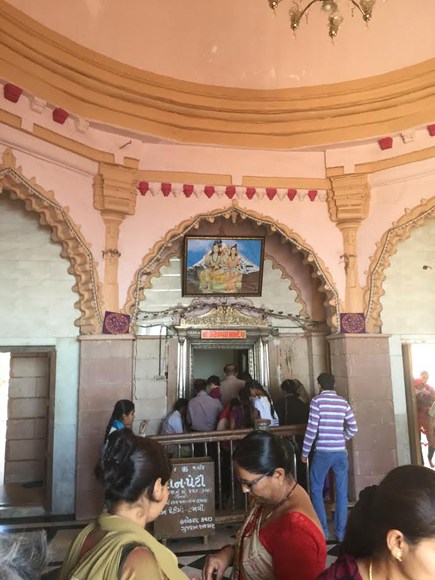

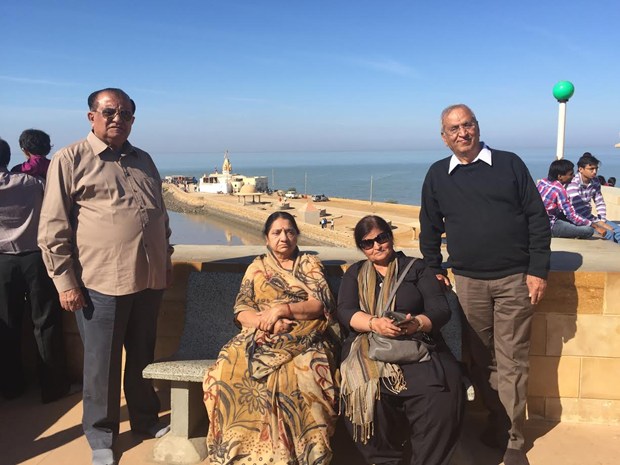
It is unfortunate that in spite of large number of visitors, the complex does not have many resources in the form of Hotels, restaurants and other information display centers. The inner road leading to Narayan Sarovar complex is a dirt path with no parking amenities. The Board in Gujarati displayed above has not been updated and no effort has been made to rectify the scratches and smudges made by some miscreants. This is one of the most important holy places of the Hindus and deserves better treatment. It is a historical place with history dating back to the Ramayan Era and yet it is neglected.
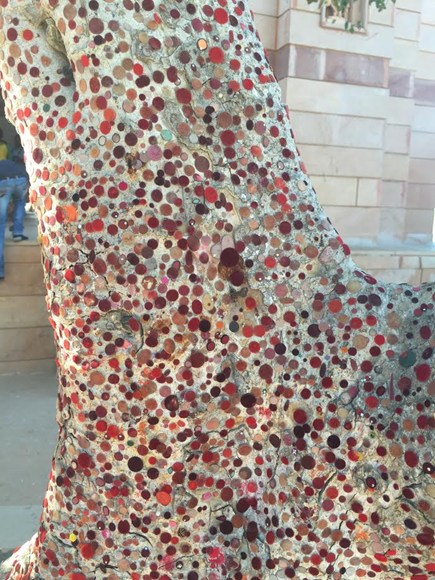
In Haridwar (Uttarakhand) there is a holy tree where people who have mansha(Wish) tie a holy thread before and after their wish is fulfilled. Here the wish is asked and fulfilled through the "Bindi".The Bindi Tree at Koteshwar.
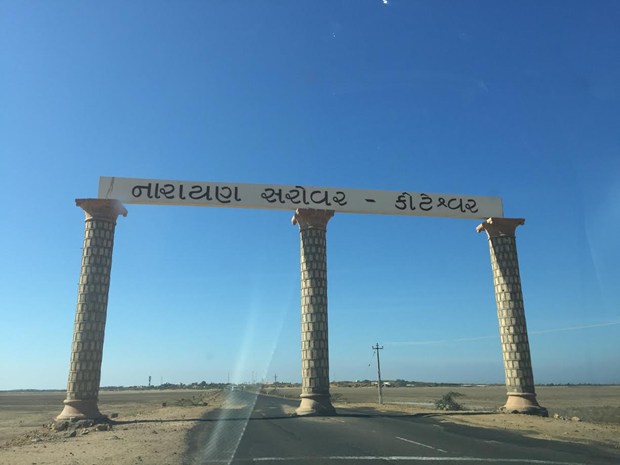
Thank You Karishma for valuable comments. Appreciated.
ReplyDeleteNice blog…thanks for sharing…its very interesting…i’m searching for this information from long time… please visit here @ http://packers-and-movers-bangalore.in/
ReplyDeleteThanks Packers and Movers, Bangalore
ReplyDeleteThanks for sharing a nice blog, we like it.
ReplyDeletehttp://kolkatapackersmovers.in/
Thanks Jyoti
ReplyDeletei like this site very much, Its a real nice situation to read and receive information.
ReplyDeletethanks for share...
http://packersmoversbangalore.in/
This is useful content. really apreciate it! Please Visit Our Webpag:
ReplyDeletehttp://packersmoversahmedabad.co.in/
Packers And Movers Ahmedabad" prompt moving, relocation and shifting services for people and corporation moving to "Amdavad" and round the India. For Movers Packers Ahmedabad city full target report on supply of revenue and effective Movers Packers in Amdavad, contact today 08290173333.
http://packersmoversahmedabad.co.in/packers-and-movers-vadodara-gujarat
http://packersmoversahmedabad.co.in/packers-and-movers-surat-gujarat
http://packersmoversahmedabad.co.in/packers-and-movers-gandhidham-gujarat
http://packersmoversahmedabad.co.in/packers-and-movers-rajkot-gujarat
http://packersmoversahmedabad.co.in/packers-and-movers-bhuj
Thank you Rhea.
ReplyDeleteThanks You all
ReplyDeletereally a vry nice blog i really appreciate all your efforts ,thank you so mch for sharing this valuable information with all of us.
ReplyDeleteYou should have to decide your things that you have to transfer and which you have to left to the old place. And for your convenience you can also make the list of your material. So that, to make sure that your all belongings are with you or not. But, we from our side also take care of all these things.
http://packers-and-movers-bangalore.in/
http://blog.packers-and-movers-bangalore.in/
really a nice blog really appreciat all your efforts,thank you so much for sharing this valuble information with all of us.
ReplyDeleteThe presence of numerous famous Packers and Movers in Pune make it entirely hard to approach the right one. Everybody appears to be equivalent to the clients and along these lines they at some point pick the wrong one and this choice end up being the greatest slip-up for them.
http://thebusinessplace.in/
i must say you had done a tremendous job,I appreciate all your efforts.Thanks alot for your writings......Waiting for a new 1..
ReplyDeletepackers and movers mumbai
Packers And Movers Ratnagiri Maharashtra
Packers And Movers Sangli Maharashtra
i cannot truly enable but admire your weblog, your weblog is so adorable and great.It has given me courage to try scarier things. I tend to steer clear of them but not anymore.
ReplyDeletePackers And Movers Lucknow
Packers And Movers lucknow" prompt moving, relocation and shifting services for people and
corporation moving to "lucknow" and round the India